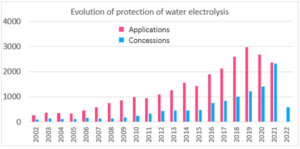Hydrogen: The Calm After the Storm
- 18 May 2022
- Articles
Besides suffering a sanitary pandemic, society is now faced with an energy consumption crisis. In some countries like Spain, the average electricity cost has skyrocketed, going from €40-65 MW/h to stabilizing over the amount of €200 MW/h, as of October 2021[1].
In this sense, the production cost, the country’s taxation, or the environmental impact of the production processes, are very important factors when understanding these values. Firstly, the high impact that non-renewable raw materials (natural gas, coal, and oil) have can be appreciated that are the main pathways for energy production in countries. The import and export of these materials presents a high impact, as we have observed in the current conflict between Russia and Ukraine.
However, as the saying usually goes: after a storm, comes a calm.
In the European Green Deal submitted by the European Commission, an initiative where the economic growth is in balance with sustainability, hydrogen production is an alternative to carbon-based energy sources, for example, in the transportation or electronic industries.
Although hydrogen is present in 75% of the universe, its industrial production is required given that it is linked to other elements such as carbon, (hydrocarbons) or oxygen, (water). There are several hydrogen production processes, which may be classified by color according to the North American Council for Freight Efficiency.
- Gray/Black Hydrogen. Obtained by means of natural gas reforming, where steam is used to react the gas and form hydrogen. In the process, greenhouse gases are released into the atmosphere. By way of estimate, in order to produce one ton of hydrogen, up to 12 tons of CO2 may be emitted. Similarly, brown hydrogen uses a fossil fuel, generally carbon. The growing environmental awareness has led to the rejection of these processes, although it is a cheap means of production, and it is competitive compared to other energy sources.
- Blue Hydrogen. Obtained by means of a process similar to gray hydrogen. However, for a greater sustainability of the process, it presents an additional storage step of pollutants, avoiding their release into the atmosphere and their reuse in other processes. Therefore, it is an evolution increasing sustainability from previous processes, although the economic impact is currently important.
- Turquoise Hydrogen. It uses pyrolysis (yes, that of current ovens) generating a decrease in the production of greenhouse gas, resulting in a gaseous stream rich in hydrogen and a solid carbonaceous residue.
- Green Hydrogen. Unlike the previous processes, in this case it is produced by means of water electrolysis, process whereby the water molecule (H2O) is broken down into hydrogen and oxygen using electricity. Through this process, no polluting gases are generated, therefore, being this the cleanest technology for hydrogen production.
- Pink Hydrogen. Lastly, pink hydrogen produced by electrolysis of the water molecule using nuclear energy, can be noted. This type of technology generates a clean product, where the advances currently made provide the basis for an individual study.
As it involves developments of a high economic impact, patent protection is of great interest.
Among the several groups of patent classifications, there is the C25B1/04 subgroup – Products generated by water hydrolysis. Despite the average delay of 2-3 years between the application and the common concession in patent prosecution processes, a great boom in the protection of solutions of this technology can be noted.
In turn, the leaders in protection of solutions can be distinguished:
- Commissariat à l’Énergie Atomique et aux Énergies Alternatives – present in numerous research projects at a European level such as MultiPLHY or GREENH2ATLANTIC to produce green hydrogen.
- Siemens AG – seeks the integration of electrolyzers for H2 production, by means of wind energy.
- Toshiba KK – among other developments, this one has H2One™, a hydrogen-based autonomous energy system.
- Industrie DE Nora SPA – electrode supplier for the biggest green hydrogen production plant in Europe.
It is evident that there are other important developments related to hydrogen production that allow for the reduction of the hydrogen production cost by means of renewable energy, substituting less sustainable energy sources, but it is clear that it is one of the most expected processes to achieve sustainability in our society.
The European Commission established a term up to 2050 for decarbonizing current processes. ¿Could hydrogen be the solution to achieve it?
Besides suffering a sanitary pandemic, society is now faced with an energy consumption crisis. In some countries like Spain, the average electricity cost has skyrocketed, going from €40-65 MW/h to stabilizing over the amount of €200 MW/h, as of October 2021[1].
In this sense, the production cost, the country’s taxation, or the environmental impact of the production processes, are very important factors when understanding these values. Firstly, the high impact that non-renewable raw materials (natural gas, coal, and oil) have can be appreciated that are the main pathways for energy production in countries. The import and export of these materials presents a high impact, as we have observed in the current conflict between Russia and Ukraine.
However, as the saying usually goes: after a storm, comes a calm.
In the European Green Deal submitted by the European Commission, an initiative where the economic growth is in balance with sustainability, hydrogen production is an alternative to carbon-based energy sources, for example, in the transportation or electronic industries.
Although hydrogen is present in 75% of the universe, its industrial production is required given that it is linked to other elements such as carbon, (hydrocarbons) or oxygen, (water). There are several hydrogen production processes, which may be classified by color according to the North American Council for Freight Efficiency.
- Gray/Black Hydrogen. Obtained by means of natural gas reforming, where steam is used to react the gas and form hydrogen. In the process, greenhouse gases are released into the atmosphere. By way of estimate, in order to produce one ton of hydrogen, up to 12 tons of CO2 may be emitted. Similarly, brown hydrogen uses a fossil fuel, generally carbon. The growing environmental awareness has led to the rejection of these processes, although it is a cheap means of production, and it is competitive compared to other energy sources.
- Blue Hydrogen. Obtained by means of a process similar to gray hydrogen. However, for a greater sustainability of the process, it presents an additional storage step of pollutants, avoiding their release into the atmosphere and their reuse in other processes. Therefore, it is an evolution increasing sustainability from previous processes, although the economic impact is currently important.
- Turquoise Hydrogen. It uses pyrolysis (yes, that of current ovens) generating a decrease in the production of greenhouse gas, resulting in a gaseous stream rich in hydrogen and a solid carbonaceous residue.
- Green Hydrogen. Unlike the previous processes, in this case it is produced by means of water electrolysis, process whereby the water molecule (H2O) is broken down into hydrogen and oxygen using electricity. Through this process, no polluting gases are generated, therefore, being this the cleanest technology for hydrogen production.
- Pink Hydrogen. Lastly, pink hydrogen produced by electrolysis of the water molecule using nuclear energy, can be noted. This type of technology generates a clean product, where the advances currently made provide the basis for an individual study.
As it involves developments of a high economic impact, patent protection is of great interest.
Among the several groups of patent classifications, there is the C25B1/04 subgroup – Products generated by water hydrolysis. Despite the average delay of 2-3 years between the application and the common concession in patent prosecution processes, a great boom in the protection of solutions of this technology can be noted.
In turn, the leaders in protection of solutions can be distinguished:
- Commissariat à l’Énergie Atomique et aux Énergies Alternatives – present in numerous research projects at a European level such as MultiPLHY or GREENH2ATLANTIC to produce green hydrogen.
- Siemens AG – seeks the integration of electrolyzers for H2 production, by means of wind energy.
- Toshiba KK – among other developments, this one has H2One™, a hydrogen-based autonomous energy system.
- Industrie DE Nora SPA – electrode supplier for the biggest green hydrogen production plant in Europe.
It is evident that there are other important developments related to hydrogen production that allow for the reduction of the hydrogen production cost by means of renewable energy, substituting less sustainable energy sources, but it is clear that it is one of the most expected processes to achieve sustainability in our society.
The European Commission established a term up to 2050 for decarbonizing current processes. ¿Could hydrogen be the solution to achieve it?
[1] https://es.statista.com/estadisticas/993787/precio-medio-final-de-la-electricidad-en-espana/










